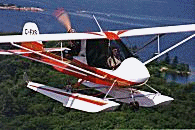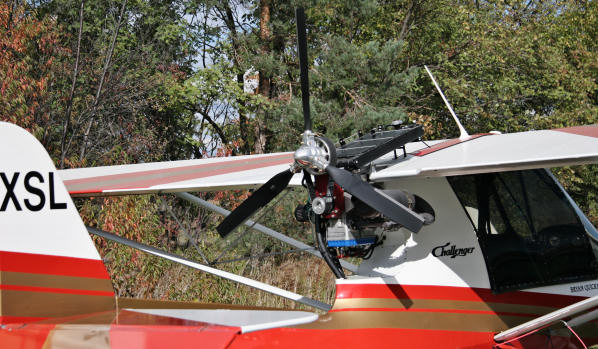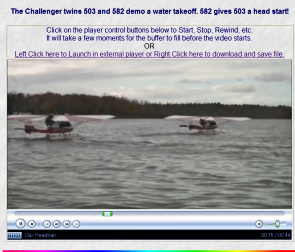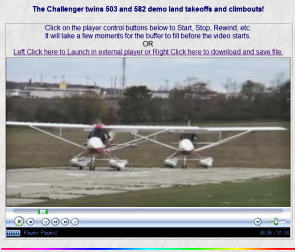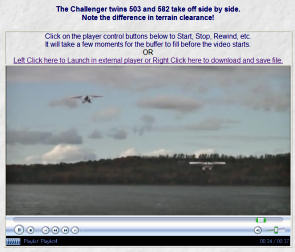|
For additional info on the Challenger 582 and 503 Power Packs The Rotax 582 is approved for Challenger aircraft in the Advanced Ultralight category when installed with the motor mount, exhaust mount, cooling system, reduction drive, prop and oil injection sourced from National Ultralight. Note that this approval is specific to 582 UL DCDI Blue Head Models. The earlier 582 Model 90, aka the Grey Head, is not approved. The approval of engines, wheels, floats and skis is contingent upon using approved installation hardware and instructions. One-off configurations or installations are not approved because it is not economically viable to do the extensive engineering analysis required to validate their airworthiness. Our Frequently Asked Questions section shows the engines, floats, skis, etc approved for the Advanced Ultralight category - see Aircraft Registration.
News Flash - June 2006: Rotax has certified the new 582 UL DCDI Blue Head Model engine used in the Challenger to meet the US Light Sport Aircraft category ASTM standards. This puts the 582 right alongside the 912 and 914. Way to go 582! Following is Bryan Quickmire's account of installing the 65 hp 582 on C-FXSL. BEFORE = 503
In the summer of 2005 I replaced the air-cooled 503 engine on my Challenger with a new liquid-cooled 582. On a brand new Challenger the process of installing a 582 is somewhat longer than for the 503 but it is straightforward. Instructions are excellent, with lots of annotated colour photos. To upgrade an existing 503 Challenger is more involved. Everything from the motor mount out to the prop except for the reduction drive must be replaced. The electric start system requires a different internal spacer and the housing has to be modified to fit. The cabin heater can be challenging to retrofit. There's a new motor mount, exhaust mount and fuel pump mount. The prop is a 3-blade ground-adjustable Warp Drive with carbon fibre blades and nickle leading edges. We use the machined aluminum hub, rather than the standard hub, since it is lighter and affords easier adjustment of the blade pitch angles. The updraft radiator is above the wing in front of the prop and sits parallel to the airflow rather than perpendicular to minimize drag. Cockpit controllable louvres, like cowl flaps or shutters, modulate the flow of the air through the rad to keep coolant temps bang on for outstanding reliability. The cabin heater is located in the fuselage below the engine and consists of a remote heater core with a three speed electric blower and recirculating ducts. All very kewl! AFTER = 582
The 582 engine is 11 lbs lighter than the 503. With cooling system and coolant plus the heavier prop and cabin heater there is a small net weight gain of about 10-20 lbs. This is completely overshadowed by 30% more horsepower and 34% more torque! All this with a specific fuel consumption 23% lower! The answer to your obvious question - how does it perform - is going to sound like an ad! The Challenger has always impressed me with how much it can wring out of the Rotax 503 - it really is a wow thanks to the light weight, huge wing and sleek airframe. No other ultralight or GA aircraft comes close, even with engines one or two sizes larger. (I told you it would sound like an ad!) Well with the 582 the Challenger goes from wow to WOW! I now have a few hundred hours on my Challenger and several others with 582's, mostly on amphibious floats but also on wheel/skis and tundra tires. The difference is especially notable in trying conditions - amphib floats, heavy loads, hot days, high altitudes. In these conditions the 582 Challenger takes off in half the distance and climbs twice as fast as the 503 Challenger. WOW! I'm also enjoying significantly improved fuel economy - about 10% less fuel at typical cruise speeds and about 45% less fuel to climb to altitude. The more efficient design of the 582 uses less fuel to produce a given amount of horsepower so at the same cruise speed as the 503 the fuel burn is lower. At wide open throttle the 582 uses only 6% more fuel to produce 30% more power so with the climb rate doubled it takes way less gas to get to altitude. With the 582 at a medium cruise power setting I get the same speed as at the 503's max cruise setting: 75 mph (TAS) on amphibs, 85 on wheels or skis. At that speed the 582's fuel burn is 16 litres/hour (4 USgph) which is about 10% less than the 503. If I slow down 10 mph for sightseeing then fuel consumption drops to 12 litres/hour (3 USgph). If I throttle up to high cruise power with the 582 then speed goes up 5-10 mph but of course so does fuel use. Unless I'm in a hurry or there's a big headwind I usually fly at medium cruise and save gas.
We had great fun in October - local owner Brent Thompson shot video of my Challenger with the 582 and John Kossup's Challenger with a 503. Both have Puddlejumper amphibious floats and long range fuel tanks. The planes are painted identically! John is a firefighter in Hamilton - his call sign is C-IZZL! Our goal was to show the relative performance of the two engines in typical recreational operations. We did not use short takeoff or aggressive techniques at minimum speeds. The throttles were advanced smoothly and slowly. On land the brakes were not held. On land and water rotation was gentle and the planes flew off rather than being hauled off or popped off into ground effect. Once airborne the aircraft were accelerated in level flight to the typical 55 mph cruise climb speed before being pitched up to commence the climb out. In the case of the 582 the acceleration is so quick there is no discernible pause between leaving the surface, achieving 55, and assuming the climb attitude! From land and water the takeoff and climb performance of both 503 and 582 Challengers is truly outstanding. In the land takeoffs the 503 Challenger was airborne in about 550 feet while the 582 Challenger took a mere 300 feet to get off. This with amphibious floats, relaxed technique and virtually calm winds! With a crosswind on the lake rather than a more helpful headwind, the water takeoffs were 7-8 seconds for the 582 and 12-14 seconds for the 503. The angle of climb difference has to be 2 to 1! The 582 Challenger gets on the step fast and charges through the waves - brute force in action - no finesse required! It's interesting to note that there was a crosswind from the left, rather than a headwind, and that the wind over the hills to the left off camera was creating downdrafts and turbulence suppressing performance. The 582 could easily have been rotated out of the water significantly earlier. Imagine this video with the wind on the nose, no downdrafts, and a more aggressive technique! If you haven't seen enough yet click here for a 582 Challenger launch on skis! On any other ultralight to come close to this you'd need a Rotax 912 which is around $25,000. That's engine alone - the mounts, prop, etc are another $5,000! And to support the extra weight you need bigger, more expensive floats, ... We timed the water takeoffs of a competitor with a 912 and amphibious floats. The 503 Challenger on amphibs gets off in the same time, at less than half the cost! The 582 Challenger takes off in half the time! Plus the Challengers cruise 10 mph faster! It's our famous big wing, light weight and sleek shape at work! On a new Challenger the 582 power pack is only $5,000 over the price of a 503. Fuel economy of the 582 is substantially better. Maintenance costs are similar. For those owners operating at higher weights on floats or at higher elevations, or those who just want a higher Coefficient of Wow, this is a very affordable route to greater performance. I'm lovin' it! For additional info on the Challenger 582 and 503 Power Packs
To learn and see more order our comprehensive information package and video! |
